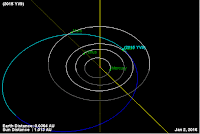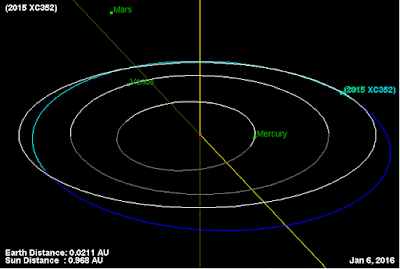Asteroid
2015 XC352 passed by the Earth at a distance of 1 991 000 km (5.18 times
the average distance between the Earth and the Moon, or 1.33% of
the average distance between the Earth and the Sun),
slightly after 7.00 pm GMT on Wednesday 30 December 2015. There was no
danger
of the asteroid
hitting us, though had it done so it would have presented only a minor
threat. 2015 XC352 has an estimated equivalent diameter of 14-43 m (i.e.
it is estimated that a spherical object with the same volume would be
14-43 m in diameter), and an object of this size would be expected to
explode in an airburst (an explosion caused by superheating from
friction with the Earth's atmosphere, which is greater than that caused
by simply falling, due to the orbital momentum of the asteroid) in the
atmosphere between 28 and 10 km above the ground, with only fragmentary
material reaching the Earth's surface.
2015 XC352 was discovered on 13 December 2015 (seventeen days before its closest approach to the Earth) by the University of Hawaii's PANSTARRS telescope
on Mount Haleakala on Maui. The designation 2015 XC352 implies that it
was the 8803rd asteroid (asteroid C352) discovered in the first half of December 2015 (period 2015 X).
2015 XC352 has a 372 day orbital period and an eccentric orbit tilted at an
angle of 4.48° to the plane of the Solar System that takes it from 0.86
AU from the Sun (i.e. 86% of the average distance at which the Earth
orbits the Sun) to 1.16 AU from the Sun (i.e. 116% of the average
distance at which the Earth orbits the Sun). It is therefore classed
as an
Apollo Group Asteroid (an asteroid that is on average further from the
Sun than the Earth, but which does get closer). This means that close
encounters between the asteroid and Earth are fairly common, with the
last thought to have happened in December 2014 this year and the next predicted in November 2016.
See also...
 Asteroid 2015 YV9 passes the Earth. Asteroid
2015 YV9 passed by the Earth at a distance of 3 602 000 km (9.37 times
the average distance between the Earth and the Moon, or 2.4`% of
the average distance between the Earth and the Sun),
slightly after 3.00 pm GMT on Saturday 26 December 2015...
Asteroid 2015 YV9 passes the Earth. Asteroid
2015 YV9 passed by the Earth at a distance of 3 602 000 km (9.37 times
the average distance between the Earth and the Moon, or 2.4`% of
the average distance between the Earth and the Sun),
slightly after 3.00 pm GMT on Saturday 26 December 2015... January's first meteor shower: The 2015 Quadrantids. The Quadrantid Meteor Shower is one of the brightest meteor showers of
the year, often producing over 100 meteors per hour at its peak, which
falls on the night...
January's first meteor shower: The 2015 Quadrantids. The Quadrantid Meteor Shower is one of the brightest meteor showers of
the year, often producing over 100 meteors per hour at its peak, which
falls on the night... Asteroid 2015 XA378 passes the Earth. Asteroid
2015 XA378 passed by the Earth at a distance of 3 857 000 km (10.0times
the average distance between the Earth and the Moon, or 3.40% of
the average distance between the Earth and the Sun),
slightly after 7.15 pm GMT on Saturday 19...
Asteroid 2015 XA378 passes the Earth. Asteroid
2015 XA378 passed by the Earth at a distance of 3 857 000 km (10.0times
the average distance between the Earth and the Moon, or 3.40% of
the average distance between the Earth and the Sun),
slightly after 7.15 pm GMT on Saturday 19...
Follow Sciency Thoughts on Facebook.

